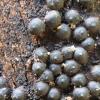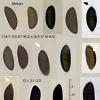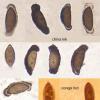
06-12-2025 00:19
 Viktorie Halasu
Viktorie Halasu
Hello, would anyone have this article, please? An

05-12-2025 17:33
 Bruno Coué
Bruno Coué
Bonjour, je serais heureux de recueillir votre avi

02-12-2025 18:59
This pair of ascos 2.5cm across were on recently b

02-12-2025 19:25
Buckwheat PeteHello, can anyone identify this hairy fungus growi

30-11-2025 12:53
 Edvin Johannesen
Edvin Johannesen
White short-stipitate apothecia found on thin twig

30-11-2025 10:47
 William Slosse
William Slosse
I recently found a collection of small Peziza sp.
Our common friend P. Zapico has found at his home these gregarious, blackish, roundish, papillate and ostiolate, carbonaceous, perithecia 0.9-1.4 mm in diam. growing over on more or less persistent subiculum on very rotten wood of a cut Salix babylonica.
The asci are cylindrical, 8-spored, 155-170 x 8.5-9 microns, pars sporifera 110-138 with a conspicuous apical apparatus Melzer deep blue 5-6 x 4 micr.
The ascospores are ellipsoid, equilateral, brownish at maturity, with straight germ slit nearly as long as spore, situated on the more convex side, and 1(-2) semiglobose cellular appendage (-s) surrounded by a partial, narrow slimy sheath. (14.7-)16.3(-18.2) x (6.5-)7.0(-8.0); Q = 2.1-2.5
I feel this fungus could be near to Rosellinia akulovii L.E. Petrini but I'd like to know your opinion.
Many thanks in advance for your help

it's good to hear from you and Pedro!
The overall morphology and the ascospores with cellular appendages and germ slit on the convex side clearly set this Rosellinia in the aquila-corticium group. Based on ascospores and apical apparatus dimensions and sheath morphology I would call it R. aquila, even though the ascospores are a bit small. I have seen a wide range of variations in this species, from small-spored collections like yours to large-spored ones grading into R. corticium. They might represent different species but they are difficult to separate based on morphology only.
I do not know R. akulovii for comparison.
Sorry Enrique, I guess you are not going to like my answer!
Cheers,
Jacques
Hi Jacques
No. I like very much your expert opinion on this very difficult genus, at least for me.
Many thanks, Jacques!





